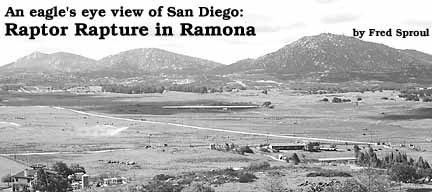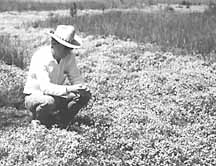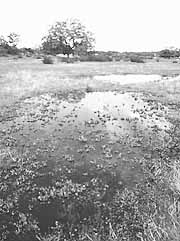![]()
![]()
![]()
![]()
![]()
![]()
![]()

![]() he large natural grassland called Ramona Valley, Flying
Eagle Ranch or Santa Maria Valley is different from any of the hills that
surround Ramona. Deep, rich soils and the watershed from the surrounding
hills have fed this productive meadow for a millennia. It has been rich
range and farmland since European settlement. At the same time, it is home
to many specialized kinds of plant and animal life.
he large natural grassland called Ramona Valley, Flying
Eagle Ranch or Santa Maria Valley is different from any of the hills that
surround Ramona. Deep, rich soils and the watershed from the surrounding
hills have fed this productive meadow for a millennia. It has been rich
range and farmland since European settlement. At the same time, it is home
to many specialized kinds of plant and animal life.

Especially notable are the birds
that visit in a hop-scotch fashion on their annual migrations. Regular occupants
and visitors include eagles, falcons and several hawk species. Particularly
important, because their habitats have been destroyed elsewhere, are the
golden eagles, bald eagles and ferruginous hawks. The gophers, ground squirrels,
mice, voles, ducks and other small birds contribute to this area's ecological
importance.
Ramona and the San Pasqual Valley remain some
of the last refuges along the Southern California coast for migrating birds.
Also still here are the burrowing owl, meadow lark, horned lard and grasshopper
sparrow. And there are cactus wrens and California gnatcatchers (both endangered
species) in the surrounding hills. Another endangered species, arroyo toads
still has a foothold in Santa Maria creek. Rarely seen, badgers live in
these fields, also coyotes, bobcats and sometimes mountain lions.
After a thunder storm, puddles of water fill
the shallow bedrock morteros like saucers set out on the granite boulders.
Other rounded boulders stick up like whales breaching in the middle of the
grasslands in Ramona. These holes were probably not for grinding acorns;
they are not near the riparian oak woodlands. More likely, they were for
the native grasses and herbs that grew on this 10,000 acre coastal prairie.
Bunch grasses like purple needle grass still dot the low hills; mounds of
alkali sacaton still line a few of its creeks and sod of creeping wildry
anchor the sinuous stream beds with the gleaming green foliage reflecting
the hot sun. A favorite of cattle on long hot days is the saltgrass which
gets munched flat to the ground. Maybe these were the grains of the ancient
Kumayaay tribes.

What made this grassland and why
is it here at all, surrounded by shrub covered hills? The answer is clay.
Crumbly beds of gray and chocolate brown clay that float like huge paddies
of seaweed on the undulating plain are what support grasslands over shrub
lands. Clays are also the reason that there are little trapped lakes left
after winter rains. These are the vernal pools and they are the proof that
this habitat has been around for a very long time. There are many plants,
a few toads and crustaceans, and lot of unknown things that have evolved
on in the vernal pools of Southern California. These pools are rich reservoirs
of life. In spring, they host riotous blooms of flowers, oodles of tadpoles
and tons of shrimp all packed into a two-month growing season. All
of these unique plants can survive harsh soils, summer drought and 'breathe
underwater' in the winter.
The vernal pools of Ramona Valley have their
own uniqueness, though there has been barely enough time to notice it as
the town of Ramona swallows up most of the main pools.

The colors fade quickly, as does
the balmy weather. But with the warm summer, football field-sized plots
of other mature flowers like tarweed expand. The camphor fragrance of the
Virgata tarweed, the strange spininess of the southern tarweed and the sunset
yellow of the fascicled tarweed all of the plants and animals that
live here are what give the land its character. They make this prairie feel
like home for the people who come from all over the county to ride bikes,
look out over the fields and mountains and to hear the unfamiliar sounds
of wind and birds without the background hum of traffic.
Altogether, the native plants that thrive in
the Santa Maria Valley are amazing in their productivity. They fatten small
mammals upon which hundreds of avian predators from as far away as the Pacific
Northwest feed. These fields are also a dependable rangeland for cattle
and an aquifer of high quality water. Considering these grasslands utility,
bounty and beauty, it shouldn't escape our attention that it all comes ready
to enjoy as a gift from nature.
![]()
 Fred Sproul is a wildlife biologist and volunteer for the Iron Mountain
Conservancy. IMC is working to protect the natural resources in the Ramona
Planning Area, the largest planning area in the County with 18% of the "developable"
land. A great deal of the land is designated as "Ag 20" by the
County and will be impacted by SOFAR's lawsuit and the proposals before
the County Board of Supervisors this month. (see article "County Faces
Contempt, page 7). Please send donations or contact IMC P.O. Box 2342, Ramona
92065, 788-WILD (9453).
Fred Sproul is a wildlife biologist and volunteer for the Iron Mountain
Conservancy. IMC is working to protect the natural resources in the Ramona
Planning Area, the largest planning area in the County with 18% of the "developable"
land. A great deal of the land is designated as "Ag 20" by the
County and will be impacted by SOFAR's lawsuit and the proposals before
the County Board of Supervisors this month. (see article "County Faces
Contempt, page 7). Please send donations or contact IMC P.O. Box 2342, Ramona
92065, 788-WILD (9453).